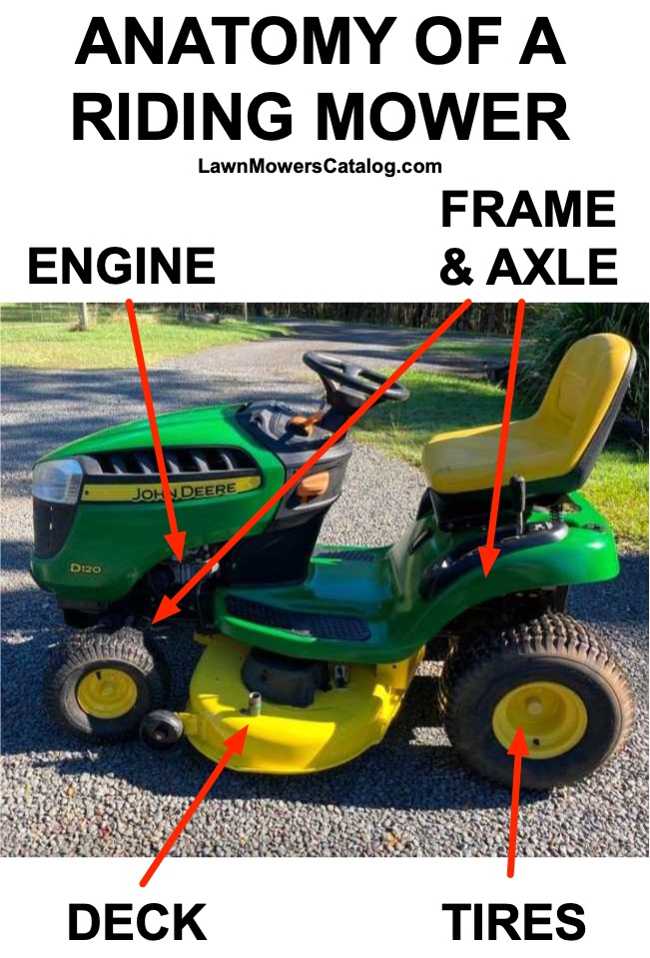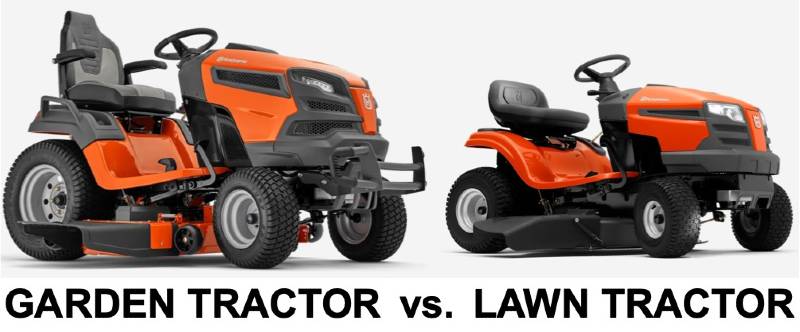People tend to call any lawn mower you ride a riding lawn mower.
But there are several distinct types of riding mowers available.
Today we will compare garden tractors vs. lawn tractors – 2 of the most popular versions of riding mowers for residential and commercial use.
The Gist: Garden Tractors vs. Lawn Tractors
- Garden tractors are more heavy-duty, more expensive, capable of using attachments like snow plow, bigger, heavier and best suited when you mow all-day-every-day and rely on it for your income.
- Lawn tractors are smaller and best for residential use and light commercial use as they have better manoeuvrability and are easier to find space to store in your garage.
- Garden tractors have a transaxle (tranny and diff in one unit), larger engine, diff locks and 4WD.
- Lawn tractors are 2WD, use a hydrostatic transmission and rear wheel drive.
Function: How Are Each Type of Riding Mower/Tractor Used (Backyard, Farm, Construction Site)?
Knowing how you will use your garden or lawn tractor is the most important thing to know before deciding which is best for you.
- Garden tractors are unique by having more hefty attachment options like baggers, large trailers and snow plows.
- Lawn tractors have attachment ability but the size of the trailer and bagger are much smaller and basically only good for small around the house jobs.
There is no doubt you should buy a garden tractor if you are using it commercially because that is what they are designed for: daily hard work. They have larger (at least) 26 HP small engines from Kawasaki and some even have Honda small engines.
Lawn tractors will be best for 1 – 2 acre home lawn which you mow weekly or bi-weekly. They usually have Kohler or Briggs & Stratton small engines. The more expensive ones may have Kawasaki or Honda brand.
Size Difference of Lawn Tractors vs Garden Tractors
Garden tractors and lawn tractors come in different weights, sizes and there is some overlap.
You may see a lawn tractor from John Deere and a garden tractor from Husqvarna be close in weight and size.
But in general garden tractors are much larger, with bigger engines, tires, and stronger components to deal with tougher tasks.
- The largest garden tractors are 2,200 lbs (1,000 kg)
- The smallest garden tractors are 660 lbs (300 kg)
- The largest lawn tractors are 660 lbs (300 kg)
- The smallest lawn tractors are 220 lbs (100 kg)

Engine
The engines garden tractors use are bigger and weigh much more.
Let’s look at an example:
- The John Deere S100 lawn tractor uses a 17.5 hp engine made by Briggs & Stratton which weighs 77 lbs (35 kg)
- The larger X700 garden tractors from John Deere use a 776cc 25HP engine that weighs 104 lbs (47 kg)
In the above example the garden tractor engine is 27 lbs (12 kg) heavier than the lawn tractor engine.
The engine accounts for about 9 – 15% of the riding mower weight. The smaller the mower the higher the percentage.
Tires
The tires on garden tractors are much bigger to deal with tougher terrain and hold the weight of the other components.
Some lawn tractors will have the same size tires front and back whereas the garden tractors all have huge rear wheels and smaller front tires.
This means lawn tractors are more easily moved around obstacles and better turning radius.
Frame
Garden tractors have thicker axle beams to hold the heavier engine, larger mower deck and generally bigger machine.
Lawn tractors – especially the entry models – will look like kids toys compared to the big garden tractors landscapers use.
In addition to the axle beams being thicker and having more cross sectional area, the sheet metal exterior of a lawn vs. garden tractor will differ by a few gauges of steel.
- The smaller the gauge the thicker the sheet metal. Gauge 3 is much heavier and thicker than gauge 20.
- Lawn tractors will use 12 gauge sheet metal (max gauge) which is 0.1046 inches (2.657 mm) thick and weighs 4.267 lb/ft2 (20.834 kg/m2).
- Garden tractors will use a thicker gauge. 10 gauge is common. It is 0.1345 inches (3.416 mm) thick.
Deck
The deck refers to the where the cutting blades are located. The wider the mowing deck the wider lanes you can mow. As garden tractors are bigger and mower powerful they have wider decks than lawn tractors. You will see lawn tractors with decks between 30 inches and 48 inches and garden tractors up to 72 inches.
How Much More Powerful Are Garden Tractors (Engine Size/Type, Transmission Size/Type)?
- Garden tractors use more powerful engines from Honda and Kawasaki in the 25 hp and above range.
- Lawn tractors use less powerful engines from Briggs & Stratton and Kohler in the less than 20 hp range.
In addition to the engine garden tractors will have 4WD, diff locks and functions to provide better traction in rough mowing and tractor conditions.
Brands of Garden Tractor vs. Lawn Tractor
There are 100s of lawn mower brands around the world but let’s look at the 10 most popular riding mower brands below:
- John Deere
- TORO
- SCAG
- Ariens
- Husqvarna
- Gravely
- Dixie Chopper
- Bad Boy Mowers
- Poulon Pro
- Troy Bilt
These brands all use engines from Honda, Kawasaki, Kohler and Briggs and are popular with homeowners and professionals alike.
So Which is Better?
Both garden tractors and lawn tractors have their pros and cons. Let’s go over them quickly here:
Garden Tractors
- Pros: Heavy duty, powerful, durable, large mowing width, plenty of attachments available, real 4WD for hills and tough conditions.
- Cons: Expensive, large and hard to manoeuvre in tight spaces.
- Best For: Professionals working as landscapers and lawn care managers.
Lawn Tractors
- Pros: Affordable, small and easy to turn in tight spots
- Cons: Less traction, less durable components
- Best For: Homeowners.
Further Reading
- Want to save money then check out our used lawn mower buying guide.
- Like baseball? Check out our guide to all the MLB stadium grasses.
- We recently updated our guide to what oil type to use in your lawn mower have a looksy.

